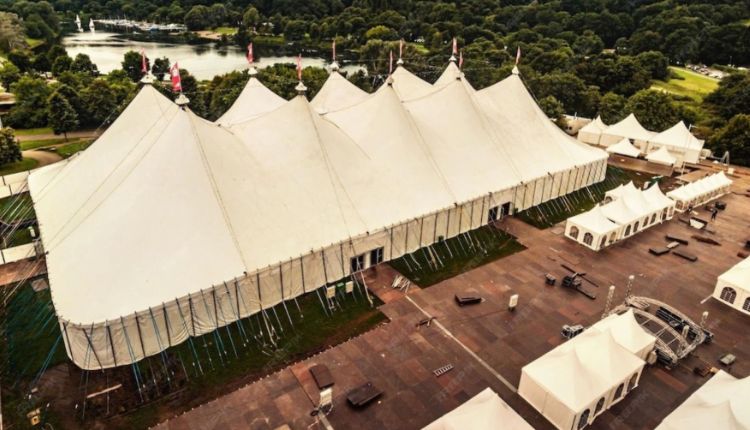When creating functional and aesthetically pleasing spaces for events, considering the right shelter will ultimately impact both logistics and presentation. The right setup provides comfort and coverage while leaving a notable impression on your audience. Many businesses utilize custom tents not only for brand awareness but also for presentation and durability in a congested event space. When selecting either a pop-up tent or a traditional shelter, it is best to examine several factors, including cost, design, durability, and the type of event or purpose for which you will use it.
Learning the distinction between two of the most popular solutions today, pop-up and traditional tents, will help exhibitors and organizers analyze whether or not the solution fits into their vision. While pop-up tents are advantageous in setup, portability, and versatility with usage, branded traditional tents are superior in durability, quality, and typically have a larger size capacity. Moreover, discussing this subject further will give a sense of which style fits the purpose.
Key Comparisons Between Pop-Up Tents and Traditional Shelters
Both options offer distinct advantages, and the right choice depends on event goals, logistics, and resources. Below are five key comparisons that highlight how each type of shelter serves different needs.
Ease of Setup and Portability
One significant advantage of a custom pop-up canopy is its quick and easy setup. Built for speed and convenience, these tents can often be set up in a matter of minutes with little to no tools and manpower. The portability is notable, with collapsible frames and lightweight materials making this tent especially convenient for businesses or organizations that frequent events.
In comparison, traditional shelters will take more time, as well as planning and manpower, to set up. Traditional shelters can also have complex frameworks and multiple elements, requiring professional installation in some cases. While these factors contribute to stability, flexibility is reduced, which is not suitable for short-term or fast-paced events where the capacity to change is crucial.
Versatility Across Events
Flexibility is also significant for both types of shelter. Pop-up tents can support many different events and are suitable for trade shows, markets, festivals, sporting events, or any community event. They are flexible since they can be used in so many different instances.
Traditional shelters are better suited to events longer in duration or larger events, which require space, infrastructure, and stability. They also excel in an environment with many participants and are a part of semi-permanent programs with long service lengths. Ultimately, the decision between the two types of shelters depends primarily on the types of events and a recurring schedule of those events.
Branding and Visual Impact
Visibility is absolutely paramount in exhibitions and trade shows. Pop-up tents allow the highest potential for customization, as they are essentially a blank canvas, allowing for logos, graphics, and colors. When it comes to busy conventions and trade shows, there is nothing more successful in getting the attention of those in the surrounding area than a visible structure. For the business that requires a certain visual extent, this is typically the only difference in exhibiting choices within an event.
Although shelters are large in size and visuals, they are typically not as easy to customize. In fact, branding often means extra banners or signage, or modifications with shelters. Shelters undoubtedly create visual presence; however, they do not create any immediate visual identification like pop-up tents do, thus making pop-up tents immensely beneficial within business events where organizations want to emphasize their brand identity.
Durability and Weather Resistance
For durability, permanent shelters generally outperform other options. They have heavier frameworks and stronger materials and can better withstand severe weather patterns (that include high winds or many days of rain). This makes a permanent shelter a desirable solution when planning for a longer-term event or in areas where the weather may cover a large spectrum of possibilities.
Pop-up tents are designed to be durable, but in general, they are much lighter. They typically do well in moderate conditions but can sometimes require extra reinforcement (like weights on the bases or tie-downs) if the weather is extreme. Most modern pop-up tents are more durable than historical ones, due to improvements in their framing, fabrics, and overall design considerations. A pop-up tent attempts to balance weight and performance features.
Cost Considerations
Budgeting is important when comparing pop-up tents to traditional shelters. Pop-up tents are easy to set up, which helps reduce overall labor costs, making them ideal for small businesses or startups that attend multiple events.
Traditionally, shelters have a higher cost; however, they are seen as long-term assets and can last longer due to their durability. However, for companies attending bigger events, the cost of the tent structure is easy to reconcile with its stability and long-term use. Ultimately, the area of spending comes down to the idea of whether your organization is more encouraged to want more constant short-term use or to build something more reliable, stable, and durable.
End Point
Both pop-up tents and traditional canopies have their pros and cons. Pop-up tents are convenient and portable, which also allows for marketing, making them the ideal shelter for any organization looking for flexibility and recognition during the event. Traditional canopies typically provide the most durability, space, and protection from weather, making them accommodations for larger or established events. Review your goals for the event and the environment you will be in, and narrow your choices down to the best shelter option.






